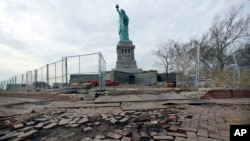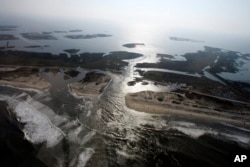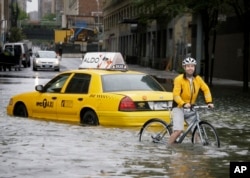Minor floods caused by rising sea levels may end up costing U.S. coastal communities as much money and resources as major hurricane disasters, U.S. scientists said.
As climate change causes sea levels to rise, such "nuisance flooding" is expected to become more frequent and costly for cities like Washington, San Francisco, Boston and Miami, researchers said.
Over the last 20 years, Washington has endured more than 94 hours a year of nuisance flooding. By 2050, the capital could see as many as 700 hours of flooding a year, the scientists estimated in a study published in the American Geophysical Union journal Earth's Future.
"Since these events are not extreme, they don't get a lot of attention," said Amir AghaKouchak, a professor of civil and environmental engineering at the University of California-Irvine and co-author of the study.
Inconvenience to public
The National Ocean Service defines nuisance flooding as "flooding that leads to public inconveniences such as road closures" but rarely causes death or injury. Such floods can overwhelm storm drains, slowly degenerate infrastructure and strain city resources.
Roads and sidewalks were not built to be under saltwater for hours on end, and cities usually have to close roads and send in trucks to clean them up, the scientists said.
"They definitely can't withstand this," said lead author Hamed Moftakhari, also of UC-Irvine. And the damage leads to "long, drawn-out costs," he added.
In Boston specifically, "king tides" overwhelm walkways and roads several times a year. The East Coast city is predicted to see up to 100 hours of such nuisance flooding a year by 2030, the UC-Irvine scientists said.
Residents have already noticed the semifrequent inconvenience, according to Mia Goldwasser, Boston's climate preparedness program manager.
"There are always people sending pictures to the city, saying, 'Look at all the flooding happening with very little rain,' " she told the Thomson Reuters Foundation in a telephone interview this week. The city has already noted several waterfront hot spots where "it's going to be worse [in the future] if there's already flooding."
More awareness
The flooding has raised awareness among the general public to the everyday realities of climate change, Goldwasser added: "It's an inconvenience to people when they're walking and driving and biking, moving around their neighborhood."
The scientists are using the data as a "call to action" for coastal cities to examine the issue and decide on the best ways to respond to rising sea levels.
"We believe that if you have information on the type of hazard, the potential cost, then you can plan," said AghaKouchak.
Boston has begun to come up with ideas to mitigate the effects of rising seas on infrastructure, which include floodproofing properties and potentially building a massive seawall.
Some roads and buildings may become corroded by nuisance floods, while others could end up completely under water, Goldwasser said.
"There's still a lot that we don't know, that we're trying to figure out," she said. "What are the most effective solutions? ... How do we actually implement them?"
As for the total cost of the floods over the next few decades, Goldwasser said that's still to be determined, though it's expected to be "pretty significant."














